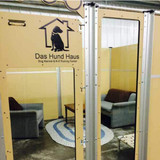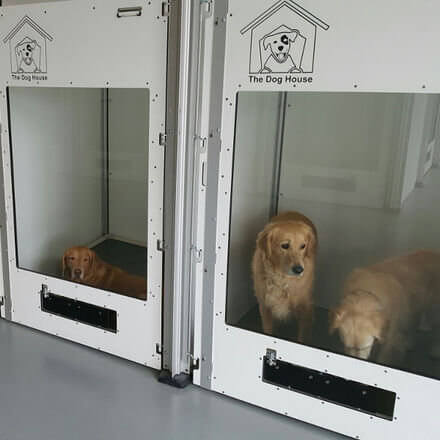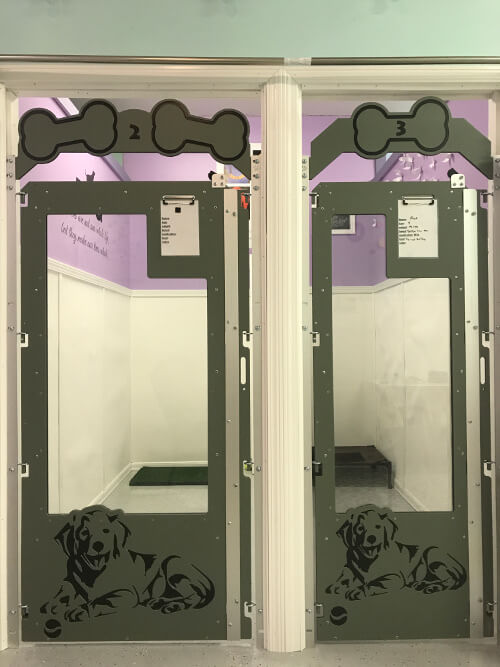Are kennels humane?

I get told over and over that it is 'inhumane to keep dogs in kennels'. I wanted to spend some time this week explaining some situations where kennels are necessary and more humane than not using a kennel.
Typically, when someone tells me that kennels are inhumane, they are referring to puppy-mills or 'rescues' that house dogs long-term in kennels that are obviously too small. These facilities also are not the best with keeping up with sanitation - which is where disease, undernourishment, and death happens.
Not every dog breeder is a puppy-mill. In fact, here in the United States we have a series of rules and regulations designed to reduce the potential for puppy-mill like conditions. Many states require on-site facility inspections, loads of paperwork to show the care and husbandry for the dogs has been taken care of, and many states do not allow dogs to be sold at retail pet-stores for profit. There is also an increasing number of states that have rules on kennels - even going as far as regulating what materials the kennels are made from! I could go on about the differences between legitimate breeders and puppy-mills - perhaps in a different article. ;Today I wanted to focus on why kennels might be necessary and in some cases - safer for the dogs!

For example, some businesses - by nature - need a place to separate dogs. We have a growing number of dog daycares and boarding facilities across the country. Some of these facilities have tried to take a 'cage-free' or kennel-free' approach - yet they still need ways to separate the dogs for feeding purposes, breaking up fights, and if a dog is sick or injured it needs to be separated from the rest of the group. The easiest way to provide separation for the dogs is using kennels of some kind. Even if the 'kennel' is as big as a room - it is still an enclosed space designed to contain a dog, and therefore: a kennel.
These boarding facilities need to separate the dogs for feeding because dogs are social pack animals and, by nature they try to establish a social hierarchy. Food increases this instinct - and these daycares do not really want the dogs to fight each other before every meal. Also, some dogs are on special diets and need special food that might make other dogs sick - or on the flip-side, a dog might find someone else's food more tasty and not eat the special diet food it needs.
Additionally, if a dog gets sick or injured, it would be dangerous to keep that dog with the rest of the pack. Again, the best solution is to move it away and a kennel is the easiest, safest place for that dog to be. For it's own safety, it can be locked in a kennel where other dogs cannot get to it. Even if the dog needs medical attention, a kennel is still the safest place to be until medical help can be acquired.

This ties right in with the veterinarians use of kennels; they need kennels to house the various critters that they are medically helping. Veterinarians not only need to contain the injured animal (so it stops causing more injury to itself - and so it does not injure the very people trying to help it) - but they also need to contain or reduce the potential for spreading diseases or infections. In this case, a smaller kennel is actually beneficial as the veterinarian does not really want the dog to run around a lot. Larger areas take longer to clean between patients. Also, if the veterinarian needs to administer an IV, oxygen, or other medically necessary treatment, keeping the dog from moving a lot will help the treatment take effect more quickly.
Of course, the goal for veterinarians use of kennels is short-term. They really want the animal to get better and out of the kennel as quick as possible - but it is a valid use of kennels that is very humane. Another short-term use of kennels is the dog groomers. They spend a lot of time and money on products to make your dog look its best. After the grooming is complete there might be some time for the dog to dry off enough to get in your car where the groomer does not want the dog running around. After all; if the dog runs around too much it might start undoing all the work the groomer just performed. Additionally, there are tools the groomer uses that helps reduce the dry-time and keeps the coat looking shiny and fresh - but if the dog is running loose it is impossible to use those tools. Again, this use of a kennel is meant for the short-term - but is a very valid (and humane) reason to use a dog kennel!
While we cannot guarantee our kennels are always used in the manner we intend, there are some things we do to help increase the comfort of the dogs inside:
- Our kennels are easy to clean and naturally anti-microbial - which reduces the potential for cross-contamination and helps control disease.
- They are also made from materials that will not get overly hot in the summer or bitterly cold in the winter. Even though we sell our kennels for indoor-use only, we want to ensure the dogs inside are at a comfortable temperature.
- The materials comply with the Department of Agriculture's recommendation for long-term animal housing - even if it will be used for short-term use.
- Our stacked kennels have a drip-lip™ at the front to keep fluids from escaping the front of the kennel and possibly dripping on the critter downstairs.
- We also do not use a wire floor in the kennels as those types of floors cut into the dog's paws and are impossible to clean.
We also try to engineer the kennels to be safer by including features that protect the occupants inside. Check out our blog post about how we make kennels safer.
Check out some of our common kennel layouts - and see how thy might work within your facility: https://www.gatorkennels.com/kennel-layouts/
Next week we will look at how we use this knowledge of how the kennels are intended to be used to make them better! Follow us on Facebook or sign up for our newsletter as we continue our series about our kennels. Feel free to give us feedback on our Facebook Page!
